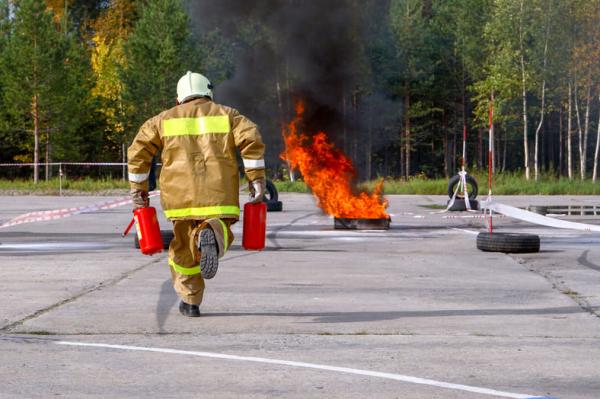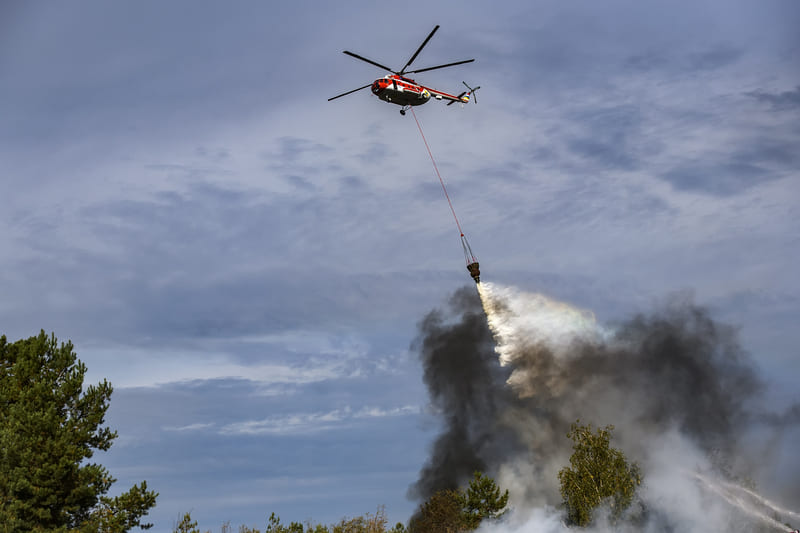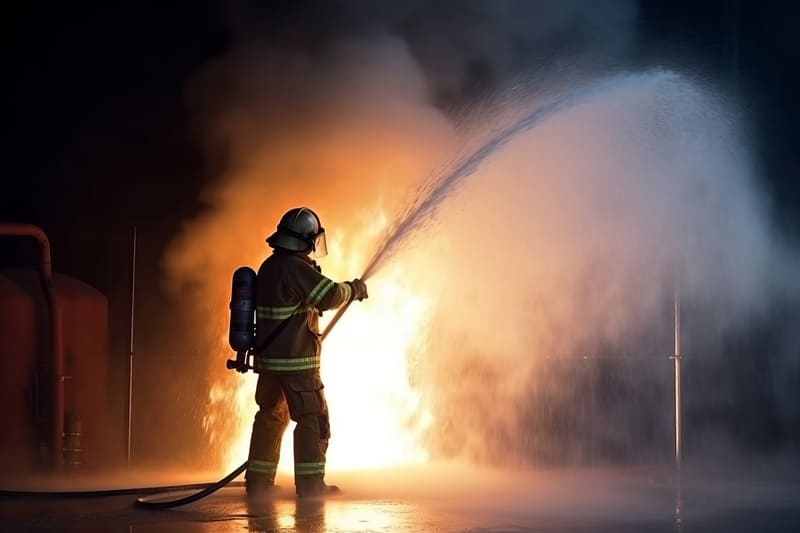Blog Post
Fire Fighting Course: Urban VS Wildland Fire Fighting Key Skills

Fire fighting is without a doubt one of the most essential skills and components to ensuring the safety of our citizens. So, you've decided to take a leap and complete a fire fighting course but you're seeking to learn more about the differences between urban and wildland fire fighting? Well, you've come to the right place.
At EMCARE we specialise in training for all fire fighting scenarios, so let's dive into some key skills for fire fighting in any sort of environment.
Key Differences Between Urban And Wildland Fire Fighting
How Fires Work In Different EnvironmentsHow Fires Work In Different Environments
In a nutshell, urban and wildfires present distinct challenges, quite simply, due to their different
environments.
Urban fires of course commonly involve structures such as homes, offices and industrial buildings. Of
course, these kinds of urban fires can often be contained within the building affected, but they also pose a
significant threat to both property and human life. Many materials involved in urban fires, such as
synthetic fabrics and chemicals can release toxic gases when combusted, which can lead to complications in
the efforts of the fire fighters dispatched to deal with it.
On the other hand, wildland fires, or wildfires break out in natural settings, such as the veld, forests,
and rural, farmland areas. These fires can rapidly spread out of control over vast landscapes and are fueled
by dry conditions and vegetation. Unlike the urban fire which can be contained by the walls of the building
on fire, wildfires have no boundaries and can (and will) consume everything in their path, in worst case
scenarios, entire ecosystems can be lost. Not to mention the unpredictable nature of weather conditions,
including wind and humidity, which can complicate things even more, regardless of whether you've completed a
fire fighting course or not.
Training And Skills Required
At EMCARE our courses emphasise the need for specialised training that is tailored to the specific needs of
both urban and wildland fire fighting. Fire fighters in the urban sprawl are trained to handle structural
fires and this involves the rescue of occupants, ventilating buildings, and of course the suppression of the
fire. They're also trained to deal with any potential hazardous materials and ensure the safety of property
and civilians.
On the other hand, wildland fire fighters require many skills in the management of fires in natural
environments. These skills include creating fire lines, conducting and overseeing controlled burns, as well
as handling several specialised tools such as chainsaws and water pump systems. Wildland fire fighting also
commonly involves working in remote areas, which means fire fighters have to be notably physically fit and
capable of managing in challenging terrain.
Our fire fighting course covers all of this as well as techniques for preserving wildlife and natural
resources, both which are crucial in wildland fire fighting.
Personal Protective Equipment (PPE) And Gear
Of course, with each form of fire fighting, comes its own set of PPE or personal protective equipment.
Urban Fire Fighting PPE
Urban fire fighting staff are kitted out with heavy bunker gear which includes fire-resistant coats, pants,
gloves, and boots which provides protection against the intense heat, flames and any hazardous substances.
In addition to the protective gear, fire fighters in urban areas are also required to carry a self-contained
breathing apparatus (SCBA) that protects them against smoke inhalation and potentially toxic fumes or gases.
Wildland Fire Fighting Gear
On the other hand, personal protective equipment for wildfires is designed for mobility and endurance, fire
fighters wear lighter, breathable gear which is also made of fire-resistant materials. Wildland fire
fighters also typically have to carry fire shelters, which provide protection in the worst-case scenario of
becoming entrapped while fire fighting. Their gear also includes protective items such as helmets, gloves,
and boots for rough terrain.

Operational Strategies And Challenges
Urban Fire Fighting Operations
Fire fighters trained in our fire fighting course who are deployed in urban areas are trained in strategies
that focus on quickly containing fires to prevent them from spreading to surrounding structures. Their
strategies include direct dousing of the fire, using both water and foam to suppress the flames and
ventilation of buildings to release heat and smoke. Being a fire fighter is no joke, as urban fire fighters
need to navigate through densely populated areas, to ensure the safety of people and minimal damage to
property.
Wildland Fire Fighting Operations
On the opposite side of the coin, wildland fire fighters employ a different set of strategies. Their primary
goal is to make sure that fires are contained within a designated area and stop it from spreading to other
regions. Their strategies include creating fire lines, employing controlled burns to reduce available fuel,
and using water and fire retardants from helicopters and other aircraft. As is the case with urban fire
fighters, wildfire fire fighters commonly work in difficult conditions, including steep and tough terrain,
and extreme weather conditions which makes communication and coordination crucial for ensuring safety and
efficiency.
Courses At EMCARE
At EMcare we offer several fire fighting courses including:
Basic Fire Awareness (BFA)
This is a course that is completed in a half-day and was developed to equip trainees with the knowledge and
skills for home and office-related fire emergencies. During this half-day course all skills and training in
fire fighting equipment is covered. You'll learn how to prevent fires from happening, how to create an
environment that is ready to manage fires, and we also teach you how to confidently step up during a fire
emergency.
The certification you'll receive upon completion is valid for two years, to learn more about this course,
click here.
Basic Fire Fighting (BFF)
This is a full-day course and is the next step after completing your Basic Fire Awareness Course, and it is
aimed at trainees who are ready to gain additional fire fighting training. In this course you'll learn more
advanced techniques and how to employ them safely and correctly during emergencies. Just like the BFP, the
certification you receive upon completion is valid for two years.
Intermediate Fire Fighting (IFF)
The next fire fighting course you would complete is the intermediate fire fighting course (IFF) which is a
two-day course that follows the BFF course. This certification will teach you the practical side of fire
fighting, and how to use hand-operated fire fighting equipment. You'll also learn more about fire prevention
and fire rescue, with the second day of the course focusing on practical fire fighting demonstrations on
fire department premises. Like the other courses mentioned above, this certificate is also valid for two
years.
Fire Fighter 1 SP & Hazmat Awareness SP (FF1)
The next fire fighting course you'd complete is the FF1 course and is regarded as a career course. It's a
nine-week course and is aimed at individuals who are keen on pursuing a professional career as a fire
fighter. This course also includes the Hazmat Awareness SP training but if you prefer you can also do this
module separately by special request. The course is offered by an EMCare affiliate company, Nirvana Business
Solutions, at our training grounds in Polokwane.
Fire Fighter 2 SP & Hazmat Operations SP (FF2)
Up next is the Fire Fighter 2 SP & Hazmat Operations SP Course, a follow up from the FF1 course. It's a
nine-week course and is the progression from the previous course and thus also intended for those seeking a
career in fire fighting. However, this fire fighting course also includes Hazmat Operations SP, which is a
step up from the Hazmat Awareness SP and can also be completed separately via special request. Lastly, this
course is also overseen by Nirvana Business Solutions on the EMCARE training grounds in Polokwane.
Hazardous Material Handling Course (HMH)
Following the completion of your BF1, AFF, FF1 and FF2 fire fighting course is the two-day Hazardous
Material Handling Course (HMH). This course is geared towards those who are seeking to learn how to identify
incidents involving hazardous materials, and how to take the necessary precautions while making the call and
waiting for assistance. Upon completion of this course, your certificate will be valid for two years.
Tips For Completing A Fire Fighting Course With EMCARE
Setting forth on the vocational career that is fire fighting is no walk in the park and nor is the training, so we've put together some tips for you ahead of signing up to do a fire fighting course.
Volunteer, Volunteer, Volunteer
Volunteering your time is essential to becoming a fire fighter and does not need to be related to fire
fighting, but it is a vital accolade to have on your CV. It is essential because many fire departments are
actively seeking individuals who regularly volunteer their time and services for the betterment and safety
of their communities.
Live A Clean, Healthy Lifestyle
Of course, we know that this is important when it comes to any career, but it is especially vital when
you're seeking a community service role such as fire fighting. If you're someone who has a tarnished track
record of anger issues, or a criminal record, if you abuse substances, this will count against you during
the hiring process. Keep it clean, healthy and positive and you'll stand out among others pursuing a career
in fire fighting.
Visit Your Local Fire Departments
It's highly recommended that you make the time to visit the local fire departments in your locale while
training to be a fire fighter. It's beneficial for your training to chat to emergency professionals,
especially fire fighters as they will no doubt provide you with support and advice and can be some of the
best mentors to guide you through the process of fire fighting courses.
Learn, Learn, Learn
Working as a fire fighter is more than just a job, it's a vocation that comes with great responsibility, so
we recommend doing as much research as possible to remain clued up on all the nuances of the fire fighting
arena. Ensure that you subscribe to publications that are relevant to emergency services, read as many
articles as possible, and as mentioned above try to spend time with professionals at fire departments.

The Home Of Expert Safety Courses
For expert and certified fire fighting courses and training, EMCARE is one of the leading health and safety academies in South Africa. If you're ready to start a fire fighting course, don't hesitate to contact us!
GET IN TOUCH
There are a few ways to reach us below. Please feel free to contact us via phone, email or you can send us a message via the form provided and we will get back to you.




















